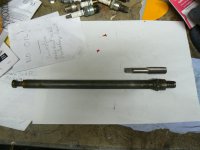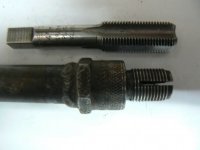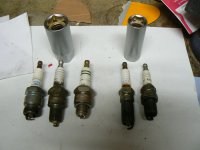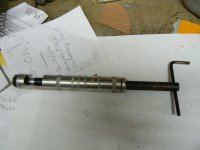How would you diagnose a plug is cross threaded? They went in nice and easy and were torqued to spec.
Cross threaded spark plug threads. By definition a cross threaded spark plug (or actually any "crossthreaded" fixing) is one where the male and female threads have become mismatched during assembly. Most usually this will be because someone has failed to correctly align the axis of the male fixing with the axis of the female (or vice versa). In other words someone has tried to install, in this case, the spark plug, on the "squint". Most cylinder heads are now made from aluminium and plugs from steel so it's the thread in the head which ends up with thread damage.
So what are the noticeable "symptoms"? In extreme cases the plug will very obviously be at an angle to the hole and if it's bad enough to see this then it's not going to screw very far into the hole before it jams up altogether and you won't be able to screw it fully home. More subtly, this unskilled person may have started it off with the thread slightly crossed up and by applying excess force managed to get the plug to actually modify and "cut" it's own way through the top few threads until it starts to line up with the rest of the threads when it can then, still using excess force, be wound all the way down. In this scenario thin little shards of damaged thread are likely to become jammed up into the remaining good bits of thread and when you come along to remove the plug it will be very tight to wind out - in fact I've had plugs where the hex end shears right off leaving the threaded portion still in the thread!
So when you are installing a plug always do it with your fingers (you may need to use a length of rubber hose or a "retainer" type socket if the plug is deeply buried in the head) but don't even think about taking a "T" bar or ratchet to it until it's well home in it's thread. If it's too tight to spin on by hand take a closer look. It may just be carbon deposits in the threads but it may well be thread damage.
If the thread damage is not too extreme you can make your own very simple thread cleaning tool. Here's mine which I made from an old Mini plug many many years ago. Above it you can see a "proper" 14mm spark plug tap and you can see that the idea is the same in that the slots in the thread allow for sharp edges which will cut into and reform - to some extent - the damaged parts of the thread:


How do you like my gas welded joint?
Here also is a good wee video by one of my favourite You tube "guys" demonstrating how to easily make one yourself and how to use it. I prefer the idea of actually cutting deep slots as I have with mine because it traps the swarf much better:
https://www.youtube.com/watch?v=yY_fuDRltZE
By the way, Anyone remember us all having a conversation about drills and thread extractors in a recent thread? I think we came to the opinion that "Dormer" was a "Rolls Royce" brand in that respect? Well this old plug tap of mine is a "Presto" - remember them? a very high quality brand too.
Whilst we are talking about plugs I've only ever had 2 sizes and they seem to fit all my needs. Here's my current haul:

There are 3 of the bigger ones marked variously 7/16W - 13/16 (presumably AF?) and 21mm. They all fit the "standard" 21mm hex found on older as well as many of the plugs still in use today. The two smaller ones are marked 10mm and 16mm with the older one being the one marked 10mm which I bought for doing the plugs on the old OHC slant 4 engines in the Bedford CF van and Vauxhall Victor. I imagine the 10mm refered to thread diameter not hex size as the newer one marked 16mm fits the same sized plugs! Just to demonstrate here's a picture of the two sizes (demonstrated by the newest sockets) and the plugs they fit:

Whilst we are on the subject, although there are many different plugs with different lengths of thread and different operating heat ranges also some have crush washers with others sealing on a taper they pretty much all use the same thread pitch - and here's a wee "pick and mix". You can see the two on the right are taper seating plugs and the one on the extreme right is one of the few "wierdies" in that it uses a bigger diameter thread (this one came from a Ford Pinto) however the vast majority are all the same size thread:

This is fortunate because if you really can't get the thread to clean up with your DIY tool then you can use a thread insert (I've shown a couple of different length examples in the picture) to effect a repair. But not a particularly easy job if you've never done one before. There are lots of cheaper kits available today which actually work quite well but only include the driver tool whereas the original Helicoil kits, like mine, had an actual installing tool:

which enabled the insert to be compressed as it was wound into it's hole which made installation, of spark plug inserts in particular, quite a bit easier to do. The big thing to remember when installing one of these "wire type" inserts is never to apply axial force, just allow it to wind itself in by twisting the installer. The insert is considerably larger in diameter than the hole you are trying to wind it into so when installed the expansion effect against the sides of the hole are what keeps it in place and, with luck, stops it comming back out again when you next remove the plug!







